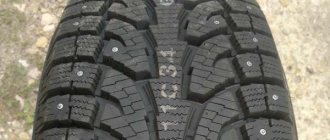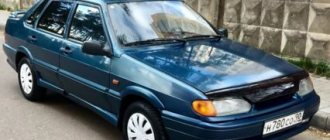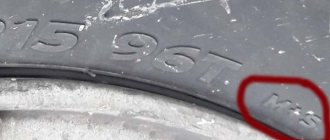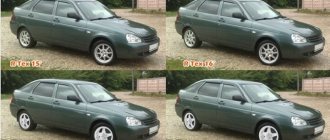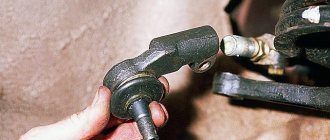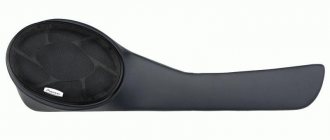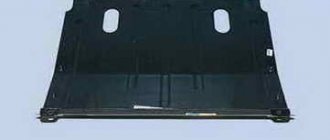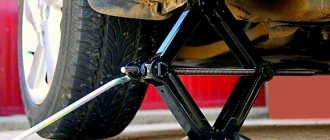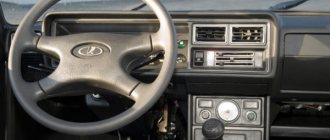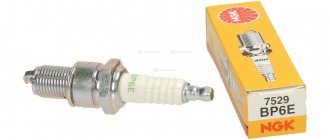Tire pressure
Car enthusiasts often ask the question: how long to pump tires and is it worth doing it for winter tires? In winter conditions, the pressure measured by the pressure gauge may be lower than it actually is. For example, an indicator of 1.7 atmospheres at a temperature of -8 degrees can be recorded by the device as 1.6 at a temperature of -20 degrees. A decrease in temperature causes a decrease in pressure.
Both low and high pressure create an incorrect contact patch, which reduces traction, and in winter this is especially fraught.
Which winter tires to choose for a VAZ 2107. which winter tires to choose for a VAZ 2107
Choosing winter tires for a car
If you need to change the tires on your car, but you don’t know which one to choose, then pay attention to this article. And only by following all the above tips will you insure yourself against purchasing a low-quality product.
Great attention must be paid to the tire size. It should be remembered that for winter roads the tire must be small in size and have a small radius. This is necessary to ensure that the car stays stable on the road.
Next, decide what you choose. We are talking about what will be on the surface of the wheel. The choice of this characteristic depends on the area in which you live. If the road is good and smooth, then you can choose Velcro. Otherwise, for rough roads, it is best to buy studs that will help deal with the crust that the ice has formed.
Cordiant winter tires from a Russian manufacturer have proven themselves very well. It has such qualities as reliability and durability.
An important factor when choosing a car tire is the tread pattern. You can choose a simple design that is made in the form of a wave pattern. The main feature of this pattern is that it is symmetrical with another pattern. It is very effective when driving on ice and snow, however, you will not be able to drive on the road where porridge has already formed.
A directional pattern can cope with such a road, in the form of a mush. However, you should not increase your speed too much on a winter road.
The best option is considered to be an asymmetrical pattern. It is able to cope with moisture, rain, as well as slippery and wet roads from snow melted with water. In order to feel confident on the road in winter, it is best to purchase a studded car. The best option in the form of a spike may be a nail. This is the most proven and best option of all the above.
If you use all the above tips and recommendations, you will be able to choose good winter tires for your car without any problems. Good luck!
Features of winter tires for cars
Many people believe that the difference between tires designed for different seasons comes down to the tread, namely its design. This is partly true; the tread pattern of winter tires is different from that of summer tires. However, the main difference lies not in the tread, but in the rubber composition itself.
The fact is that at negative temperatures, rubber changes its properties - it becomes hard, while the quality of the grip of the “hardened” rubber decreases. In winter tires, the composition has been changed so that it remains soft even at low temperatures.
But this condition also has a negative role - such rubber becomes even softer at positive temperatures, which leads to the fact that driving the car becomes more difficult, it begins to float a little on the road. Additionally, winter tires are often equipped with metal studs to improve wheel traction on snow and ice.
However, not all winter tires...
equipped with spikes - another type of stingray is produced, without spikes. Popularly, such tires are called “Velcro” or “cobwebs”. The fine, specially applied tread of these tires provides reliable grip on winter roads even without the use of studs.
All-season tires, which are supposedly designed for both summer and winter cold, are also popular among people. This is not an entirely correct judgment; rather, these are tires for the autumn-spring period, since in summer they are not hard enough, and in winter they do not have the required softness.
So you shouldn’t take any chances, and in winter use only tires designed for this period.
So, now the market offers a large number of winter tires for cars, including for our automobile industry; winter tires are sold for VAZ classics, as well as the new generation - 21099, 2110-2114.
One of the significant conditions...
When choosing winter tires for a VAZ, the “wallet size” factor is considered. After all, a lot of companies, both domestic and foreign, are engaged in the production of tires.
But this criterion also has one underlying reason - often tires from European manufacturers are designed for their winters, where the temperature is higher than ours. As a result, expensive tires can perform much worse on the highway than inexpensive domestic ones.
To say unequivocally which winter tires are better for classics and which for other models -
impossible, since each driver has his own opinion. Some people like Nokan Hakkapeliitta, which are considered one of the best, while others are content with the domestic Rosava, and consider the tires of this manufacturer to be quite good. You can also note such companies as Hankook and Bridgestone, they also have tires that can be installed on VAZ. But in general, it all depends on the money available, as well as on certain preferences - “studded” or “Velcro”, with a symmetrical or directional pattern.
Disk options
When choosing wheels for a VAZ 2107, strength, balancing and wheel sizes are taken into account. The main parameters that people pay attention to when purchasing are radius and width. The manufacturer equipped the car with standard wheels marked 5Jx13H2 ET29. The numbers and letters indicate the following:
- “5” – rim width, in inches;
- “J” – profile;
- “13” – disc rim diameter, in inches;
- “H2” – number of humps on the wheel rim;
- “ET” – letter designation of wheel rim offset;
- “29” – rim offset, in mm.
Valid disk parameters are:
- The number of holes and the diameter of the circle on the wheel rims (bolt pattern) is 4x98 mm.
- Hub diameter – 58.5 mm.
- Rim diameter – 13-15”.
- Wheel offset – 15 – 30 mm.
- Recommended width is 5.0-6.0”.
- Fastening elements – M12x1.25.
It is better not to install wider rims on the “seven”. You need to select the appropriate tires for them. They are larger in size than the size of the fender liners, and can touch or rub against the structural elements of the car.
Consequences of installing wide disks:
- Rapid contamination of the side parts of the machine.
- When the wheels turn, they rub against the side member and wings of the body, which leads to intense wear and damage to the car.
- While driving, the tires can touch the brakes, and this can lead to an accident on the road.
- Increased wear on wheel hub bearings, as they will bear more load.
Size of tires and wheels on VAZ 2110 - required pressure
Below we will consider all possible sizes of tires and wheels on the VAZ 2110, as well as the required pressure.
Size of tires and wheels on VAZ 2110 (1995 - 2015) - required pressure
Main characteristics:
- Hub center hole diameter: 58.6 mm.
- Thread and thread pitch: M12 x 1.25.
- Fastening type: Bolt.
| Engine/Power | Tire | Disk | Bolt pattern | Pressure front axle/rear axle |
| 1.5i: i4 petrol / 58 kW | 79 l. With. 1.5i 16V: i4 petrol / 69 kW | 94 l. With. 1.6i: i4 petrol / 60kW | 81 l. With. 1.6i 16V: i4 petrol / 66 kW | 90 l. With. 1.8i: i4 petrol / 72 kW | 98 l. With. | 175/70R13 | 5Jx13 ET35 | 4×98 | 1.9 (28) |
| 175/65R14 | 5Jx14ET35 | 4×98 | 2.0 (29) | |
| 175/65R14 | 5.5Jx14ET35 | 4×98 | 2.0 (29) | |
| 185/60R14 | 6Jx14 ET35 | 4×98 | 2.0 (29) | |
| 185/55R15 | 6Jx15 ET35 | 4×98 | 2.1 (30) | |
| 195/50R15 | 6.5Jx15 ET35 | 4×98 | 2.1 (30) |
Main characteristics:
- Hub center hole diameter: 58.6 mm.
- Thread and thread pitch: M12 x 1.25.
- Fastening type: Bolt.
| Engine/Power | Tire | Disk | Bolt pattern | Pressure front axle/rear axle |
| 2.0i: i4 petrol / 110kW | 150 l. With. | 195/60R15 | 5Jx15 ET35 | 4×98 | 2.0 (29) |
| 205/55R15 | 6Jx15 ET38 | 4×98 | 2.1 (30) | |
| 205/50R16 | 6.5Jx16ET33 | 4×98 | 2.1 (30) | |
| 215/45R17 | 7Jx17 ET27 | 4×98 | 2.3 (33) |
What to look for when choosing winter tires
Manufacturers today offer many models of winter tires. For every taste and income. The price, naturally, cannot but worry any owner of a car that needs new tires installed. But saving on this purchase is not recommended. First of all, you need to evaluate the performance characteristics of the rubber.
What is important for a car owner choosing a set of tires for driving on roads in winter:
- Tire size. In this case, you should follow the recommendations of the car manufacturer. However, you need to understand that wider wheels are less effective in lateral drifts, and narrow ones are worse for getting out of snowdrifts. Regarding height: it is recommended to consider slightly higher options compared to their summer counterparts.
- Load index. The higher this number, the stiffer the tire will be. But due to a more durable frame, it will be able to better withstand movement on roads with broken surfaces.
- Speed index. It is necessary to estimate the usual speed of movement. If it does not exceed 100 km/h, there is no need to purchase tires with an index higher than K (up to 110 km/h).
- Date of manufacture. Since the warranty period established by the tire manufacturer usually does not exceed 5 years, it is recommended to pay attention to this aspect.
- Type of tread. Depending on the conditions in which the car is intended to be used, you need to choose the shape of the pattern. To overcome snowdrifts, it is better to consider a model with large-sized checkers. Small lamellas in the form of checkers are more versatile. The rounded sidewall increases the risk of skidding.
- Presence of thorns. As already noted, they help when moving along the ice crust.
All the information necessary for the consumer is usually indicated on the tire itself (see photo).
What drivers operating vehicles in winter need to remember:
- You cannot drive on both summer and all-season tires;
- It is not recommended to purchase used tires;
- You cannot limit yourself to installing winter tires only on the drive wheels.
The best winter studded tires for the VAZ-2110
Studded tires will save the driver and his car from troubles when traveling on icy roads.
The best inexpensive models of such tires from domestic manufacturers are presented in our review.
Viatti Brina Nordico V-522
Description of the tire. The model received an asymmetrical pattern, in which the central longitudinal rib is shifted closer to the inside. This arrangement improves the vehicle's directional stability and promotes stable handling.
A large number of diagonal contact blocks located in the middle blocks makes for reliable braking on roads with any surface.
The tread in this model is studded along the shoulder areas. It allows you to keep the car on a slippery highway and maintain stability when changing lanes.
The entire width of the profile is covered with lamellas of different shapes and directions. Their upper parts are equipped with hard edges, with the help of which the tire tenaciously holds the car on a slippery surface.
Pros of Viatti Brina Nordico V-522
- Excellent cross-country ability on snow.
- High-quality braking.
- Reliable compound.
- Adequate cost.
- Confident grip on ice, slush, and wet asphalt.
- Easy balancing.
Cons of Viatti Brina Nordico V-522
- Noisy tires.
Owners of these tires believe that their price corresponds to the quality of the model. In terms of performance properties, it is not much inferior to studded winter tires from well-known brands.
Kama-Euro-519
Description of the tire. A characteristic feature of the model is the presence of a large number of studs installed on a symmetrical directional tread.
Their hard tips reliably bite into the icy crust of roads, holding the car in various modes of movement.
Nizhnekamsk manufacturers use high quality materials when producing: natural rubber, polymer additives. Such a mixture remains elastic in severe frosts and does not lose performance characteristics.
Wide recesses between the shoulder contact blocks extend far to the sides. This arrangement allows the driver to confidently get out of drifts on the road and improves cross-country ability.
The directional V-shaped arrangement of the contact patches of the central zone promotes precise control and supports movement at high speed.
Pros of Kama-Euro-519
- Acceptable price.
- Excellent driving performance at low outside temperatures.
- Confident behavior in a rut.
- Decent braking on snow, wet or dry asphalt, and ice crust.
- Reliable installation of spikes, they do not fall out.
- Wear resistance.
Cons of Kama-Euro-519
- Needs running in - increased noise level.
This model has good driving properties and is inexpensive, its owners note. They recommend it for purchase.
R13 or R14
Another important issue is the possibility of switching from standard R13 tires to R14. This issue is controversial; it comes down to tires rather than wheels. Since the disc size is larger, this affects the profile height. The lower the profile, the more the rubber will transmit road unevenness to the suspension, which will ultimately result in an increase in driving rigidity, but the car's handling will improve.
But if you take into account that the handling will improve slightly, but the possibility of damaging the disk itself or the slope on potholes will increase, then it is still better to use disks on the car assigned by the manufacturer.
Many car enthusiasts in VAZs use R14 wheels in the summer, and in the winter they switch to R13, and stamped wheels.
Which tire should I choose?
Marking of standard tires on VAZ 2107 is 175/70R13 82T.
“175” — tire profile width;
“70” - the ratio of parameters such as the height and width of the tire profile;
“R” is the designation for a radial tire (note that this is not a radius, as most people incorrectly believe);
“13” is the diameter of its landing (namely the diameter, not the radius);
“82” is the load capacity index, which indicates how much pressure can be applied to each tire;
"T" is the maximum speed at which this tire can be used.
When choosing tires for the summer, take into account the climatic conditions and characteristics of your place of residence. For example, if you live in a rainy climate with poor road surfaces, you might want to consider tires with tread and a good drainage system that quickly pushes out water, preventing the effect of hydroplaning. The latter is the worst thing that can happen to you on a wet track, the car glides along the track like a ship, while the driver completely loses control over the steering.
The tread pattern plays an important role; it determines how the tires will grip the road. If you live in places where the tracks are mostly wet, it is recommended to choose tires with an asymmetrical deep pattern. Often this type of tire contains the corresponding inscription “Rain”, which translated into “human” means “rain”; you can also often find the word “Aqua”, which is practically the same thing and is translated as “water”.
How to choose tires
I decided on some parameters in advance - I definitely decided that I would buy studded tires. I live in a small town where the roads are not always cleaned; sometimes I go out of town. If you live in a region where there is a real Russian winter, then there is no alternative to thorns.
Velcro performs much worse on ice than studded tires. Of course, it is quieter and more comfortable, but if you make a choice between comfort and safety, then the second is more important.
I decided exactly what brand of tires I would buy. The last car had Michelin X Ice North 2.
I've driven it 65 thousand km in 7 years and it still looks fine. Over time it has lost its properties, but most of the thorns have been preserved. The tires are comfortable and performed well on slippery roads and asphalt.
I also decided to put Michelin on the Lada Vesta; last year a new modification, X Ice North 4, was released.
I read a lot of reviews, feedback, comments. This is one of the best tires available today. You shouldn't skimp on tires. If you compare the braking distance at 100 km per hour on good tires and cheap ones, the difference is 30-40 meters.
Of course, tires cannot provide a guarantee, and you can fly off the track with any tires. But high-quality wheels will help you avoid an accident, and the chance of this is much higher.
Often people do not have enough money, they buy the tires they earned. Something else is not clear - cheap tires on alloy wheels. It is better to buy high-quality rubber, but stamped ones. Beauty and tuning are good, but safety is more important.
In contact with
“VAZ Car Owners Club” is a community of like-minded people where you can exchange opinions on the forum, start your own blog or read smart thoughts on the pages of other club members, as well as learn the latest news from the world of cars and everything connected with them. Tuning, spare parts, emerging problems and their solutions, pitfalls of buying and selling, and much, much more.
On the pages of the “Club” every owner of a VAZ car, and even those simply interested in this domestic brand, will find something interesting, useful and necessary for themselves!
TOP 4 winter tires R14 for crossovers
Michelin X-Ice North XIN2
The studded tire for crossovers has balanced characteristics. It uses 12 stud lines and 2 layers of rubber. The external one is responsible for maintaining elasticity in the contact patch. The inner layer has increased rigidity. Flex-Ice compound with increased amounts of silicon helps improve wear resistance and grip quality.
fast acceleration and braking on ice, snow, asphalt;
low fuel consumption;
There are comments about the smoothness of the ride.
Gislaved Nord*Frost 200
Eco Tri-Star studs are lightweight but provide excellent traction on ice. The asymmetrical tread pattern helps maintain control on any type of surface. A large number of lamellas effectively cope with self-cleaning and create additional hook edges.
predictable handling on snow and ice;
good grip;
low noise level;
there are comments regarding directional stability;
Average acceleration and braking on ice and snow.
Cordiant Snow Cross
Studded winter tires have a pronounced directionality, which helps maintain directional stability when driving. Rigid blocks do not break and ensure confident cornering. Zigzag lamellas and a developed shoulder area guarantee good cross-country ability.
fast acceleration and braking on snow and ice;
low fuel consumption;
There are comments about braking on wet and dry asphalt.
The best all-season tires for the VAZ-2110
All-season tires are in particular demand among Russian drivers. It allows you to use one set for a long time, without wasting time on off-season “change of shoes.”
The performance properties of the rubber compound enable these tires to function normally in the summer and winter seasons.
Kama-365 (NK-241)
Description of the tire. The model is characterized by large tread blocks located diagonally, as well as deep recesses designed to drain snow and water.
Powerful shoulder blocks reliably hold the car on wet or muddy roads. The wide slots of the grooves separating them contribute to good maneuverability on dirt roads or snowy sections of the road.
The robust design of the model, made of high-quality steel, as well as the seamless production technology of a synthetic breaker, makes the tire resistant to deformation.
Two central powerful stiffening ribs allow the driver to maintain directional stability in various driving modes.
The rounded transition from the tread to the side allows the rubber to instantly respond to steering inputs and improves control.
Pros of Kama-365 (NK-241)
- Low noise level.
- Reasonable price.
- Predictable control.
- Elastic tire at slightly sub-zero temperatures.
- Long service life.
Cons of Kama-365 (NK-241)
- Defective products are received.
